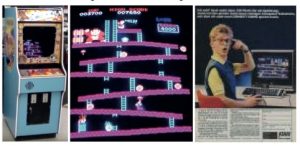START: „Video game interaction has no color, no language barrier, no judgement“ (English / German)
Atari XL, C64, Apple II – die 80er Jahre waren das Jahrzehnt der Heimcomputer, die in Deutschland in schwelende Technik-Angst-Debatten und Gewalt-Diskurse hineinstießen und dabei die rasante Entwicklung von Bildschirmspielen zur Unterhaltung und auch Bildungszwecke insgesamt bald überschatteten. „Bildschirm-Spiele“ gab es zu diesem Zeitpunkt schon längst. Etablierte Spielkonsolensysteme wie das Atari 2600 waren um 1980 herum nach Europa gekommen und schnell zu einem Jugendphänomen geworden. Ihren Ursprung hatten sie in den USA, wo der Markt bereits ab den frühen 1970er Jahren rapide gewachsen war und sich längst erbitterte Kämpfe um Marktanteile und Patente abzeichneten. Neben den großen bekannten Namen wie Coleco, Intellivision oder Atari versuchte auch die amerikanische Firma APF in den 1970er Jahren von dem rasant wachsenden Kuchen der Heim-Bildschirmunterhaltung einen großen Bissen abzubekommen. APF hatte als Hersteller von preisgünstigen Taschenrechnern schon Mitte der 70er schnell auf den Boom von billigen Pong-Nachbauten gesetzt. 1978 kopierte APF dann die Strategie von Atari, Konsolen mit auswechselbaren Spielmodulen anzubieten, bevor 1979 der Versuch unternommen wurde, auf den in Fahrt kommenden Zug von preisgünstigen Heimcomputern aufzuspringen. Die Spiele- und Computerentwicklungen von APF wurden maßgeblich entwickelt von Ed Smith, einem jungen Ingenieur, der eine große Leidenschaft für Mathematik und Computer und Videospiele hatte. Von anderen Mitarbeitern der Spieleindustrie unterschied ihn jedoch allein… seine Hautfarbe. Ed Smith ist einer von heute nur zwei bekannten schwarzen Spiele-Hardwareentwicklern der 1970er Jahre. Im Interview gibt Ed Smith einen kritischen Einblick in den Geist einer aufblühenden Industrie und Prof. Dr. Stefan Piasecki bietet einen Überblick über die frühen Jahre der Videospiele.
Atari XL, C64, Apple II – the 1980s became the decade of home computers, suddenly plunging into smoldering and fearful debates on technology and violence on screen in Germany, overshadowing the rapid development of screen games as a new tool for entertainment and recreation and also a possibility for education. „TV games“ had already been available for quite a while at this time. Successfully established game console systems like the Atari 2600 had been introduced in Europe around 1980 and quickly became a youth phenomenon. Their original US market had grown rapidly since the early 1970s and fierce battles for market shares and patents had already begun. In addition to the huge well-known names such as Coleco, Intellivision or Atari, the Manhattan-based company APF also tried to benefit from the rapidly growing market for home screen entertainment in the 1970s. Being a manufacturer of low-cost pocket calculators up until the mid-1970s, APF had quickly understood the power and influence of arcade games to individuals and closely witnessed Atari´s attempts to extend the success they had with their arcade machine PONG and to sell simplified versions for home use. APF was one of the first and most successful producers of cheap Pong console clones for family TV sets. Later in 1978, APF also adopted Atari’s new strategy of offering consoles with interchangeable game modules before attempting to leap onto the upstarting trend of budget home computers in 1979. Their game and computer development was largely developed by Ed Smith, a young engineer who had a great passion for math and computer sciences and of course video games. However, one aspect made him appear slightly different from other game industry employees … his skin color. Ed Smith is one of only two black game hardware developers of the 1970s known today. In the interview, Ed Smith gives a critical insight into the spirit of a flourishing industry and Prof. Dr. Stefan Piasecki sheds light on the early years of video gaming.
VIDEO: Ed Smith on his 40+ years of engineering work for APF, Apple, Novell and others


